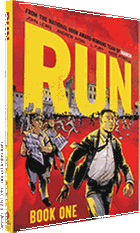
The March trilogy was a magisterial, National Book Award-winning achievement that provided an accessible and dramatic narrative account of John Lewis's involvement in the civil rights movement. The trilogy concluded with one of the movement's greatest triumphs, the passing of the Voting Rights Act of 1965. Run: Book One picks up where March: Book Three left off, as reactionary forces pushed back against the movement's successes and the movement itself began to splinter. Published after Lewis's death in 2020, Run: Book One is a reminder that the story of the civil rights struggle does not have a neat ending; for Lewis and so many others, the work never ended.
The graphic novel opens with an ominous sight: the title of the book is announced over a two-page spread of Ku Klux Klan members marching. It makes for a disturbing reversal of the many scenes of civil rights marches in the previous trilogy, with Georgia KKK Grand Dragon Calvin Craig even shown co-opting Lewis and the Student Nonviolent Coordinating Committee's (SNCC) own tactics as he instructs his marchers: "If you might become too... emotional, please stay behind. There'll be no catcalling, no responding if anyone hollers at you." Run quickly establishes that soon after the passing of the Voting Rights Act of 1965, forces were gathering to fight back, and those forces would make use of a variety of strategies in addition to brute violence.
The art in Run: Book One maintains a similar style to the March trilogy: black and white and cleanly drawn, with the lack of visual clutter putting an emphasis on realism and legibility. These books are drawn in a way that both carefully documents history--the many historical figures are recognizable and easy to distinguish--and also provides an accessible reading experience. In the March trilogy, artist Nate Powell was gifted at showcasing the inspiring sweep of protest marches, as well as the solidarity and discipline of the marchers. Here, Powell and L. Fury use their talents to show the strength of the forces arrayed against civil rights activists like Lewis.
At the same time that reactionary forces were gathering, divisions were growing within SNCC under the chairmanship of Lewis. As violence intensified in the cities, the doctrine of nonviolence preached by Lewis and Martin Luther King, Jr., began to fall out of favor. Disagreements about strategy, tactics and even ideology intensified as firebrands like Stokely Carmichael began to use slogans like "Black Power" that had greater appeal to the young and angry. All of this dissension is portrayed through John Lewis's eyes, manifesting as a rising tide that he can do little to stop. As Lyndon Johnson's administration became increasingly unreachable and noncooperative, there arose an increasing sense that Black Americans needed to make change on their own. While Lewis remains gracious toward his rivals, extending a great deal of understanding to the roots of their anger, he makes his dismay clear at the emotionally charged debates that rocked SNCC, the aggressive power grab that lost him the chairmanship, and the loss of the "unity of purpose" that propelled the march from Selma.
It is here that Run is at its most personally devastating, showing how Lewis's exhaustion at the physical demands of his job was accompanied by a kind of spiritual exhaustion, a powerlessness at watching an organization that he helped build leave him behind. Even more than the trials and tribulations depicted in the March trilogy, Run: Book One feels like a true dark night of the soul for Lewis, as his loneliness and alienation become increasingly apparent. After Lewis leaves SNCC, one panel shows him halfway through a set of double doors, looking back inside, toward the light, while holding a box filled with his things. Even depicted at a distance, in profile, we see the regret and exhaustion in Lewis's downcast expression and his slightly hunched posture. Outside, we see nothing but darkness, while Lewis reflects:
"A riot is the language of the unheard," Dr King would say. "What is it that America has failed to hear?" And as Dr. King felt the movement slipping away, my life as I knew it was over. And I could feel everything slipping away... I was twenty-six years old... I was broke... I had no job... For my entire adult life, the movement had been my family. I had no wife... No children... No place to even call home anymore."
Run is more than a personal narrative, of course, providing a valuable history of a period that is often skimmed over in textbooks, explaining the roots of the Black Power movement, the Black Panthers and the turn toward more militant activism. At the same time, we learn about the ways reactionary forces sought to limit the effects of the Voting Rights Act through violence and intimidation, as well as more subtle means. The authors and artists don't shy away from obvious parallels to the present day: from the voter suppression that followed the Voting Rights Act to acts of police violence that precipitated explosions of rage in the cities. Equally valuable for those studying John Lewis's life are the lessons he has to offer about the difficulties of organizing and activism, such as the way divisions over strategy can widen into impassable differences. The ending of Run: Book One promises a pivot, as Lewis's inexhaustible career continues into a new phase in New York City. Over time, we know Lewis will find incredible political success, but Run: Book One is a valuable reminder that even heroes like John Lewis faced crises that they couldn't resolve. --Hank Stephenson

